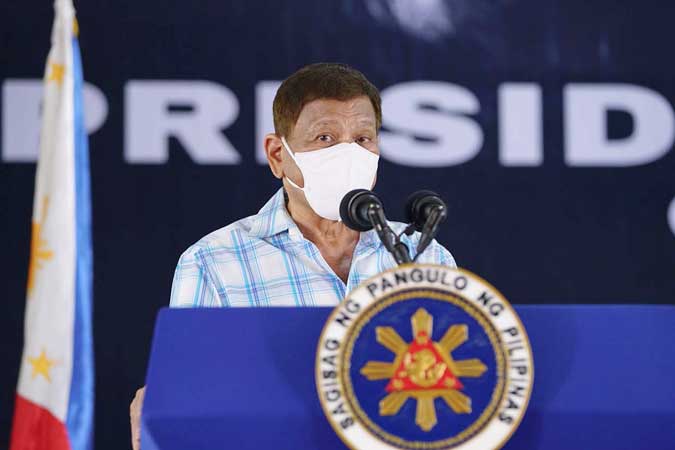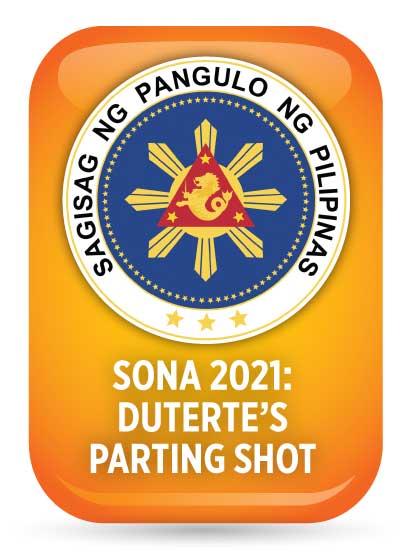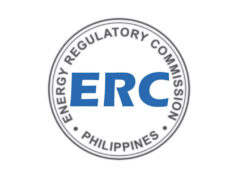
By Beatrice M. Laforga, Reporter
THE DUTERTE GOVERNMENT took over at a time of high economic growth, with momentum provided by the reforms pursued by his predecessors. The administration’s signature tax reform program would have added to the growth story and drawn in more investment to infrastructure, had the pandemic not imposed its own demands for massive funding.
In the government’s fifth year, the coronavirus disease 2019 (COVID-19) ended the high-growth streak and sent the economy crashing to a record contraction of 9.6% in 2020.
Perhaps President Rodrigo R. Duterte’s best hope for a semi-graceful exit lies in making a successful final push to contain the outbreak while stimulating growth in any way he can. He can achieve this through his preferred avenue of “Build, Build, Build” to create employment and address years of infrastructure neglect, or, if Congress and some economists had their way, open up the purse strings for a third stimulus package before any further damage is done to the economy — and just before all significant political work grinds to a halt for the May 2022 elections.
 “The Duterte administration should at least get the economy on track before handing it over to the next administration — get the economy out of recession, stabilize inflation within healthy bands, keep interest rates healthy for both borrowers and lenders, achieve a stable exchange rate, and finish or at least keep on track the infrastructure projects ensuring a smooth transition of these projects so resources are not wasted,” John Paolo R. Rivera, economist at the Asian Institute of Management, said in an e-mail.
“The Duterte administration should at least get the economy on track before handing it over to the next administration — get the economy out of recession, stabilize inflation within healthy bands, keep interest rates healthy for both borrowers and lenders, achieve a stable exchange rate, and finish or at least keep on track the infrastructure projects ensuring a smooth transition of these projects so resources are not wasted,” John Paolo R. Rivera, economist at the Asian Institute of Management, said in an e-mail.
He said these can only happen if a significant portion of the population is vaccinated and the economy fully reopens.
At midweek last week, the Philippines had administered about 16.4 million vaccine doses, with 5.56 million or 5.1% of the population having undergone the full two-shot program, some distance away from the goal of fully vaccinating 70 million people to achieve herd immunity.
The target of fully inoculating half of Metro Manila’s population by November should be sufficient to reopen the economy further and for the recovery to gain momentum, according to Asian Development Bank (ADB) Philippines Country Director Kelly Bird.
However, he said key structural reforms are still crucial in bringing the economy back to its long-term growth trajectory.
“The Philippines, like all other countries, is focused on bringing the COVID-19 pandemic to an end and ensuring the economic recovery is on a solid footing this year and next year. Ending the pandemic will be at the forefront of policy-making decisions in 2021 and early 2022,” Mr. Bird said in an e-mail to BusinessWorld.
Action for Economic Reforms (AER), a public policy think tank, believes the government can only address its biggest roadblocks if it changes its approach to handling the public health crisis and if the economic team finally agrees to boost spending to keep the economy from sustaining permanent damage.
“The government must learn from the negative lessons of allowing institutional gridlock, policy incoherence, and inadequate budgetary support. Resolving these problems can hopefully lead to optimism that will predict sound economic recovery,” AER Coordinator Filomeno S. Sta. Ana III said.
The government has been placing Metro Manila and other parts of the country in and out of lockdown for more than a year since the COVID-19 pandemic first took hold in March 2020.
Despite this, the Philippines continues to register around 5,000-6,000 new cases each day, with more than 55,000 active cases as of July 23.
RECAP
Prior to the pandemic, the economy was posting robust growth rates in the first four years of the Duterte administration, though the rate of expansion slowed each year. Gross domestic product (GDP) rose 7.1% in 2016, 6.9% in 2017, 6.3% in 2018 and 6.1% in 2019.
Poverty rates had fallen to a low of 16.7% in 2018 from 23.3% in 2015, while unemployment fell to 5.1% in 2019, its lowest level in 14 years.
The second half of Mr. Duterte’s term, however, witnessed an unprecedented crisis that reversed the strides made in recent years, with more than two million Filipinos estimated to have fallen into poverty last year after the jobless rate hit a record 17.6% in April 2020, the peak days of the initial lockdown.
“The Duterte administration’s economic policy has been proactively reformist, pro-poor, and pro-regional. The reform agenda has been comprehensive and well targeted and lays a strong foundation for a resilient, high-growth economy. At the same time, the government has pursued a pro-poor social protection agenda helping to lift millions out of poverty,” the ADB’s Mr. Bird said.
The “Build, Build, Build” program, touted as a major growth driver, promised to deliver P8 trillion worth of infrastructure projects.
ADB’s Mr. Bird judged that the government’s commitment to increase annual public spending on infrastructure to over 5% of GDP via a focus on big-ticket items would spur growth, create jobs and boost countryside development.
The administration spent P3.417 trillion on infrastructure between 2016 and 2019, and had planned to spend P1 trillion each year over the second half of the presidential term.
For reference, past administrations had spent the equivalent of 1-2.5% of GDP on infrastructure.
The program has met with its share of delays and bureaucratic snags.
“The ‘Build, Build, Build’ program has been plagued by perennial problems such as right-of-way acquisition, the technical deficit in government agencies, political lobbying, and issues in bidding and contracting,” Philip Arnold P. Tuaño, chairman of Ateneo de Manila University’s Department of Economics, said.
The building program’s cost required a major overhaul of the tax system to shore up revenue, perhaps reforming the way the government collects taxes for the long haul.
Among the tax measures passed were the Tax Reform for Acceleration and Inclusion (TRAIN) law, various sin tax laws, two tax amnesty programs, and the Corporate Recovery and Tax Incentives for Enterprises Act (CREATE).
While these measures helped the government better manage deficits, IBON Foundation Executive Director Sonny A. Africa said the tax system become the “most regressive it has ever been” after the TRAIN law raised the tax burden on the poorest 75% of the population, while a majority of the savings from the reduction of corporate tax under CREATE benefited larger firms and not small businesses.
With the little time remaining for the administration to relieve the burden on the poor, Mr. Africa said the government should immediately release a bigger round of stimulus checks to low-income households, provide tax relief to small businesses and extend wage subsidies once again.
PRIORITIES
Mr. Duterte is set to deliver his sixth and final State of the Nation Address (SONA) today (July 26), and analysts are expecting him to put key structural reforms in the spotlight to ensure the economy’s long-term growth prospects, while pursuing his infrastructure program despite the challenges ahead.
Even though political distractions with the approach of the 2022 national elections are beginning to cloud policy direction, analysts said the President needs to bring the remaining items of his reform agenda across the finish line before he steps down.
“I would like to highlight these priorities I believe are game changers for the Philippines and will support job creation and long-term growth. These include proposed amendments to the Public Service Act which will further relax restrictions on foreign investment and job creation, the Investment Act, and the Retail Liberalization Act,” the ADB’s Mr. Bird said.
“I also personally think enacting best-practice reforms to the apprenticeship program are necessary to help young people transition into jobs and address the Philippines’ skills deficit,” he added.
Calixto V. Chikiamco, president of the Foundation for Economic Freedom (FEF), said: “It’s probably too late for the administration to push for new legislation in the run-up to the elections in May 2022. Congress will be too distracted to consider new bills.”
However, he said the administration should still strive to complete the remaining items of its comprehensive tax reform program, some of which are in advanced stages of the legislative process.
These include real property valuation reform to improve local government finances and the Passive Income and Financial Intermediary Taxation Act (PIFITA), which proposes to simplify the tax regime for passive income earners.
The government should also focus on completing “Build, Build, Build” projects, especially those that will be affected by the public works ban ahead of the May elections, according to Michael L. Ricafort, chief economist at Rizal Commercial Banking Corp.
He added that a faster rollout of the national ID program, as well as streamlining of public services and processes in both the national and local government offices, should likewise be prioritized.
Meanwhile, Mr. Tuaño, the Ateneo economist, said a final push is also needed to reform the education system, which will help lay the groundwork for the economy’s future productivity.
“The pandemic has resulted in poorer levels of education (fewer students in school), health and nutrition (higher levels of malnutrition) and other basic needs. These trends have a long-term impact on the growth potential of our country and unfortunately, it is not clear what the government’s response is in several of these areas,” he said.
Aside from hitting poverty reduction targets, he said the government should also shore up the deteriorating position of the middle class and vulnerable groups, especially after the pandemic cost millions their jobs here and overseas.
Stronger support for agriculture and small- and medium-sized enterprises, as well as cutting red tape were also cited as priority action areas.
IBON Foundation’s Mr. Africa said the government should not simply seek a return to the pre-pandemic status quo as its goal for economic recovery, but instead aim for more inclusive and sustainable growth.
He rejected “a mere return to the situation in 2019… (to) an economy overly reliant on external sources of growth with hollowed-out domestic agriculture and Filipino industry.”
“It was also inequitable, had widespread poverty, and was ecologically unsustainable. The administration should not just restore that economy but rather reform it towards a more inclusive, equitable, and sustainable one,” Mr. Africa added.



